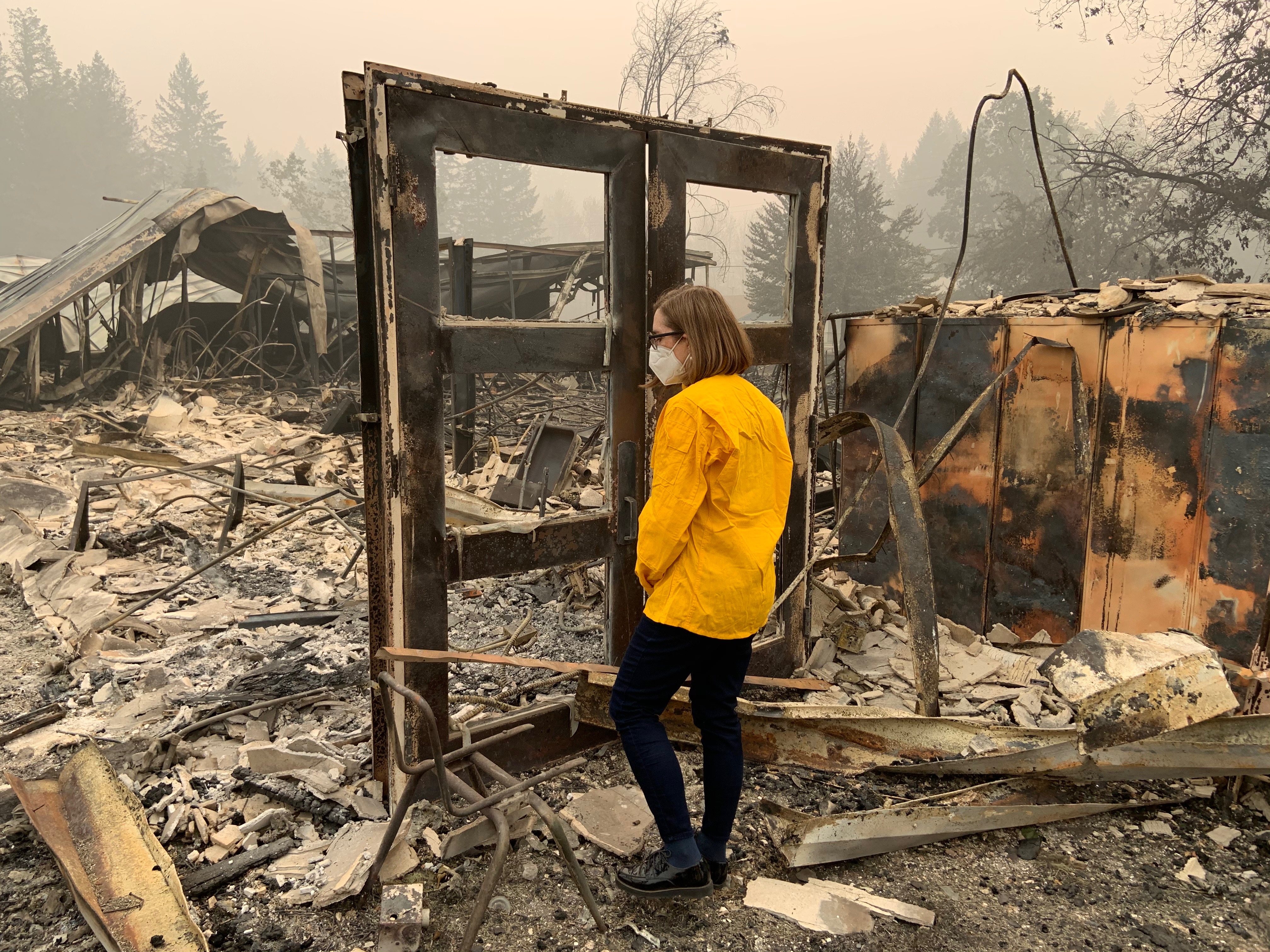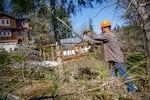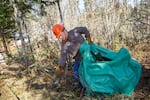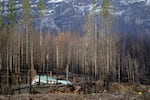
Oregon Gov. Kate Brown tours an area damaged by the Beachie Creek Fire, Sept. 16, 2020. The Beachie Creek Fire swept through the Santiam Canyon area.
Office of Gov. Kate Brown
Aaron Blacklock is leading his crew in a team warm-up before they start their work day.
“If you could fill a pool with anything and jump into it, what would it be?” he asks the group as they stretch.
Normally, these Northwest Youth Corps crews work in the wilderness, maintaining trails or pulling weeds and replanting trees after wildfires.
But today, as they imagine jumping into a pool filled with Jell-O or pillow stuffing, they’re surrounded by homes. As they whack down a thicket of blackberry brambles and invasive weeds in the neighborhood forest with hedge trimmers and brush cutters, they look a lot like a landscaping crew.
They’re basically doing extreme yard work. Northwest Youth Corps Executive Director Jeff Parker said this is one of the ways Oregon plans to avoid the kind of fires that destroyed thousands of homes and killed nine people last Labor Day.

Joshua Wright of Oregon's Wildfire Workforce Corps clears undergrowth in a Eugene community to help reduce the risk of wildfire in the neighborhood, March 30, 2021.
Kristyna Wentz-Graff / OPB
“Our objective here is to do fire prevention to make sure our community has resiliency so that it could survive a fire,” Parker said. “So that if a fire does roll through it doesn’t have the catastrophic impact, the mass displacement of people and the impact on the community.”
This time last year, Oregon was in the midst of its most destructive wildfire season ever. Now, Oregon has a $220 million plan to prevent that kind of catastrophic wildfire in the future. This year, lawmakers passed Senate Bill 762, a sweeping wildfire preparedness package that covers everything from requiring electric utilities to file risk reduction plans to funding clean air shelters to protect vulnerable people from smoke.
In signing the bill, Gov. Kate Brown said the 2020 fire season underscored the need to modernize Oregon’s approach to wildfire.
“I don’t think any of us will forget the horror as we saw towns burned overnight, thousands evacuated their homes, leaving behind all of their belongings,” she said. “We were simply not equipped to fight the fires of this new age, which are faster and more fierce and fueled by the impacts of climate change.”
The bill makes big investments in reducing the trees and brush that could fuel a fire through logging and prescribed burning. And it pays for increased firefighting capacity. But it doesn’t stop there. It also calls for mapping fire risk across the state and changing how we build and maintain homes and communities in fire-prone areas.

Joshua Wright of Oregon's Wildfire Workforce Corps clears undergrowth in a Eugene community to help reduce the risk of wildfire in the neighborhood, March 30, 2021.
Kristyna Wentz-Graff / OPB
Parker said drooping tree limbs surrounded by thickets of weeds in the natural areas of Eugene’s South Hills could fuel a fire and send it moving faster and hotter through the surrounding neighborhoods.
“A lot of the homeowners associations up here have these natural areas. That’s what makes them attractive to the residents,” Parker said. “But they fall into this space where they may not be getting a lot of landscape maintenance. This one in particular that we’re looking at was really loaded with fuel.”
Clearing that fuel is part of a new program called the Wildfire Workforce Corps that provides young people with paid job training and experience as well as college tuition credit.
The program has $11 million in funding through Oregon’s new wildfire protection plan to work in the “home ignition zone” in areas like the South Hills of Eugene, where forests and other wildlands meet houses. Collectively, these areas are called the wildland urban interface, or WUI, and they’re known to face higher fire risks.
But exactly where those places are in Oregon is a point of contention now that lawmakers have decided those are the places that need the most regulation to reduce wildfire risk.
What areas are most at risk?
Sen. Jeff Golden, D-Ashland, who led the effort to pass SB 762, said it’s important to know what parts of the state are most at risk from wildfire and prioritize action in those areas.
“Nobody’s even beginning to think we’re going to eliminate wildfire going forward but just reduce risks and protect communities,” he said. “We’re fighting for our survival in a very real way, and there’s a lot of trends working against us.”
Golden said fire risk maps will have the biggest influence over which areas will see the strictest new fire-safe building codes and requirements for clearing defensible space of flammable material around homes. But those rules will have the biggest impact in wildland urban interface areas because that’s where one home can endanger an entire community.
“If you overlay the extreme risk zones on the wildland urban interface, if you’re in both, you’re likely to be looking at some defensible space and building code requirements going forward,” Golden said. “We are looking for a balance between letting people do exactly what they want on their private property and responding to this existential threat.”

Vince Piper and his wife Lynne had only owned their 17-acre property in Elkhorn a short time before it was destroyed by the 2020 Beachie Creek Fire.
Kristyna Wentz-Graff / OPB
During the legislative session, critics of SB 762 sounded alarms about the potential for broad restrictions to have unintended consequences for property owners, home builders and farmers.
“If Senator Golden thinks for a minute I’m going to cut down the 200-year-old, 200-foot-tall, old growth ponderosa pine in my yard he is mistaken,” Sen. Betsy Johnson said on the Tillamook Today radio show earlier this year.
“I’m just not sure I want unseen, unaccountable, unelected bureaucrats dictating the future of the state of Oregon and how we all are going to live on our own property.”
Johnson joined a chorus of other critics including the Oregon Farm Bureau and Oregon Property Owners Association in pushing for more public input on the rulemaking process.
The pushback led to a plan that allows committees of stakeholder groups to weigh in on the rules that will determine which properties will see the most regulation.
One rulemaking advisory group is focused on how to define and identify wildland urban interface areas. Another is involved in developing wildfire risk maps and creating an appeals process for property owners who disagree with their risk classification.

More than 50 mobile homes in this park in Talent were completely destroyed by the 2020 Almeda Fire. Oregon has a new plan to reduce the risk of homes burning in future fires.
Brandon Swanson / OPB
Dave Hunnicutt, president of the Oregon Property Owners Association, said he’s worried that a broad definition of the WUI will lead to regulations in rural places that don’t need them.
For example, he said, a small woodland owner might be required to cut down trees that would otherwise be profitable crops in order to comply with defensible space standards that require clearing vegetation around homes.
“It’s not so much what the regulations are. It’s where they’re going to apply,” Hunnicutt said. “There are a few urban areas in Oregon, but most of the state is decidedly rural. Crafting policies that treat rural property owners as if they were in the center of town or on the edge of town is something we just can’t support.”
The public input process required for rulemaking means it will take a while before all the rules are in place.
The Oregon State Fire Marshal has a deadline of October 2022 to set new standards for clearing defensible space around homes, and the same deadline applies to the Oregon Department of Consumer and Business Services to develop wildfire hazard building code standards.
A fire hardened home can survive
Firefighters and scientists say evidence clearly shows which measures help protect homes from burning in fires.
In the Santiam Canyon’s Elkhorn community, Mary Bradshaw’s home proves their point.
The home she built with her husband in 2010 was untouched by the Beachie Creek wildfire that burned through her neighborhood and leveled all of the surrounding homes.
“We were shocked,” Bradshaw said. “Having seen what the fire did, we really didn’t expect it to be standing.”
She and her husband built their home with a metal roof, no gutters or air vents, concrete board siding, a cement porch and no vegetation up against the house. Those are all key measures that experts recommend for fire-proofing homes.
“We built it with fire in mind, although we never thought we’d have a fire,” Bradshaw said.

Mary Bradshaw's home in Elkhorn, Feb. 26, 2021. Bradshaw's fire-hardened home was one of the only ones that survived the Beachie Creek Fire in the area.
Kristyna Wentz-Graff / OPB
Many of the measures they took in building their home also helped reduce the amount of maintenance they would need to do as they aged, she said.
After evacuating during the fire, they returned to find the home wasn’t even damaged by smoke from the fire that clearly burned through the entire neighborhood.
“We had no idea what the damage inside would be, and there was none other than we continue to get ash from outside,” Bradshaw said. “We expected a horrible smell but the only place we found a horrible smell was inside the refrigerator, which I had neglected to empty before we left.”
Bob Horton, fire chief for Jackson County Fire District #3, is a vocal supporter of SB 762. He said his agency spends quite a bit of time helping people in the district assess their homes and remove flammable materials from their properties because it makes a big difference in reducing fire risks.
“It’s less fuel for the fire to continue to feed off of, and it also gives fire crews an opportunity to take an offensive posture and be able to suppress a fire,” he said.
Horton said the measures have been voluntary, but in places with high fire risk it should be required.
“There’s no doubt that wildfire is posing a significant threat to our communities,” he said “The incidents of wildfire have been growing in size and complexity and in intensity. We are seeing more frequent fires. My wife and I have been evacuated from our home three times since we moved to Southern Oregon.”
Over the next year, Oregon will be debating how many of the recommendations for creating fire-safe communities should be mandatory and where.



